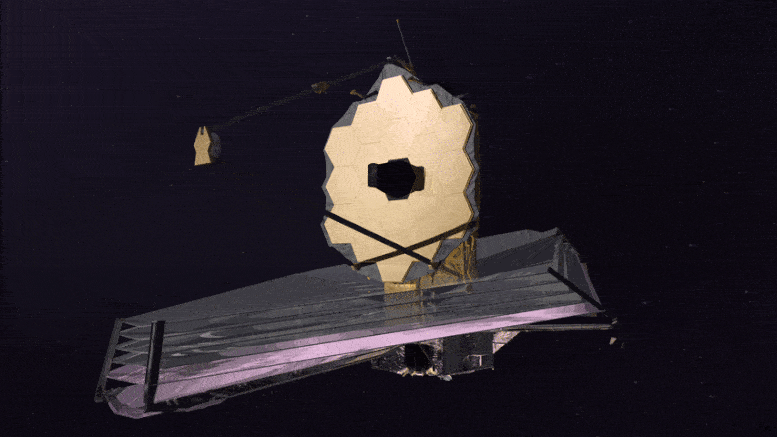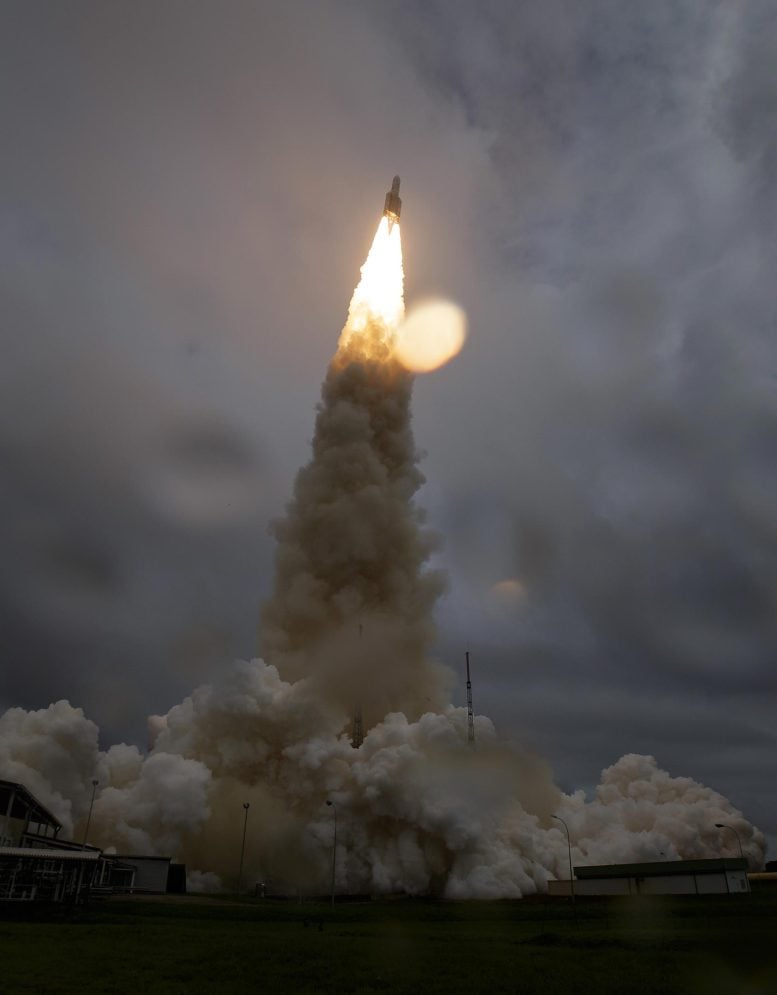
NASA’s James Webb Space Telescope. Credit: NASA’s Goddard Space Flight Center Conceptual Image Lab
After a successful launch of NASA’s James Webb Space Telescope on December 25, and completion of two mid-course correction maneuvers, the Webb team has analyzed its initial trajectory and determined the observatory should have enough propellant to allow support of science operations in orbit for significantly more than a 10-year science lifetime. (The minimum baseline for the mission is five years.)

Arianespace’s Ariane 5 rocket launches with NASA’s James Webb Space Telescope onboard, Saturday, December 25, 2021, from the ELA-3 Launch Zone of Europe’s Spaceport at the Guiana Space Centre in Kourou, French Guiana. The James Webb Space Telescope (sometimes called JWST or Webb) is a large infrared telescope with a 21.3 foot (6.5 meter) primary mirror. The observatory will study every phase of cosmic history—from within our solar system to the most distant observable galaxies in the early universe. Credit: NASA/Bill Ingalls
The analysis shows that less propellant than originally planned for is needed to correct Webb’s trajectory toward its final orbit around the second Lagrange point known as L2, a point of gravitational balance on the far side of Earth away from the Sun. Consequently, Webb will have much more than the baseline estimate of propellant – though many factors could ultimately affect Webb’s duration of operation.
Webb has rocket propellant onboard not only for midcourse correction and insertion into orbit around L2, but also for necessary functions during the life of the mission, including “station keeping” maneuvers – small thruster burns to adjust Webb’s orbit — as well as what’s known as momentum management, which maintains Webb’s orientation in space.
The extra propellant is largely due to the precision of the Arianespace Ariane 5 launch, which exceeded the requirements needed to put Webb on the right path, as well as the precision of the first mid-course correction maneuver – a relatively small, 65-minute burn after launch that added approximately 45 mph (20 meters/sec) to the observatory’s speed. A second correction maneuver occurred on December 27, adding around 6.3 mph (2.8 meters/sec) to the speed.
The accuracy of the launch trajectory had another result: the timing of the solar array deployment. That deployment was executed automatically after separation from the Ariane 5 based on a stored command to deploy either when Webb reached a certain attitude toward the Sun ideal for capturing sunlight to power the observatory – or automatically at 33 minutes after launch. Because Webb was already in the correct attitude after separation from the Ariane 5 second stage, the solar array was able to deploy about a minute and a half after separation, approximately 29 minutes after launch.
From here on, all deployments are human-controlled so deployment timing – or even their order — may change. Explore what’s planned here.
https://news.google.com/__i/rss/rd/articles/CBMifGh0dHBzOi8vc2NpdGVjaGRhaWx5LmNvbS9kdWUtdG8tcHJlY2lzaW9uLWxhdW5jaC1uYXNhLXNheXMtd2ViYi1zcGFjZS10ZWxlc2NvcGVzLWZ1ZWwtbGlrZWx5LXRvLWxhc3Qtd2F5LW1vcmUtdGhhbi0xMC15ZWFycy_SAQA?oc=5
2021-12-30 10:17:49Z
1205415723
Tidak ada komentar:
Posting Komentar